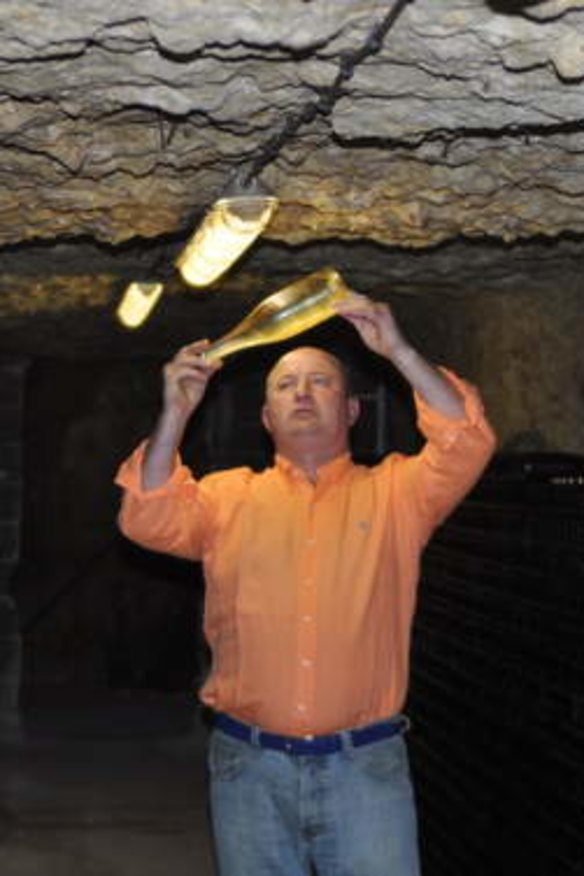After centuries, the perfect note
It has taken hundreds of years to produce the great chenin blanc wines of Vouvray in the Loire Valley.

Vouvray is one of the world's most exceptional wine regions. Its ancient vineyards on the north bank of the Loire, near the city of Tours, grow on a kind of limestone known locally as tuffeaux.
Some of the vineyards date back to the 6th century, when monks tended the grapes. Into the cliff-like bank of the river the locals have dug tunnels that penetrate deep into the tuffeaux. Troglodytes once lived there, although the 80 per cent to 90 per cent humidity probably didn't do their lungs much good. Later, the locals used the tunnels to house their animals on winter nights, or to store stock-feed and farm implements. Today, wine companies such as Marc Bredif use the old tunnels and galleries to store their bottled wines at the ideal temperature of 12C.
At Marc Bredif, the winemaker takes visitors to a round cave at the end of a tunnel to conduct the tasting. Thirty-five metres above this gallery, vineyards are growing. Occasionally they find old vine roots penetrating the chalk.
Up above on the plateau, the winemaker for Domaine Huet points out, are ancient walled vineyards called clos, where the chenin blanc vine produces its best wines. Clos du Bourg is Huet's finest. Its six hectares of vines are cultivated biodynamically, as are all Huet's vines. Nearby is another famous walled vineyard, Clos Baudoin, which has lately changed hands and is now part of the domaine of Francois Chidaine.
The great wines of Vouvray are made only from chenin blanc. In Australia and most other countries, chenin blanc produces a pretty ordinary and rather neutral wine. It is one of the world's most graphic demonstrations of terroir that in Vouvray – and across the river in Montlouis – the chenin blanc gives great wine. The vine, the soil and the mesoclimate come together to give perfection, like three notes of a chord. The vital fourth component, of course, is the hand of man – and the experience accumulated over centuries of cultivating this vine in this land could be said to be the fourth note of the chord.
Chenin blanc is amazing here, because it produces not just one wine but a whole array of wines – sparkling and still wines of different degrees of sweetness and richness. The still wines range from dry or sec to half-dry or demi-sec, to sweet or doux, and finally to the very rich sweet wines often made from botrytis-affected grapes, called moelleux or liquoreux. These are the pinnacle of Vouvray, and are among the greatest sweet whites in the world. They live a long time – I've tasted great moelleux wines from as far back as 1947. On my latest visit Bredif opened a 1959 that was heavenly. The 1990 is also a great vintage, sublime to drink now, and promises to be just as long-lived.
Francois Chidaine told me that when he took over the Clos Baudoin, the then owner, Prince Philippe Poniatowski, opened an 1874 for him – the oldest Vouvray he's tasted.
Generally, the drier wines don't live as long as the sweet, but Christophe Pichot at Domaine Pichot opened a 1954 sec – my birth year – which was remarkably good; not a great year but still drinking very well, although I like to think I have more years ahead of me than the wine.
At its best, old Vouvray has a gold to amber colour, a tremendously complex bouquet of honey, poached fruits, grilled nuts, vanilla and toasted bread, and the sweet wines have great richness and character in the mouth, the substantial sweetness balanced by high acidity and concentrated flavour. Vouvray moelleux is never sickly sweet, and is not sweet for the sake of sweetness. It is beautifully balanced, and often less sweet than we might expect.
I maintain the most enjoyable style of Vouvray is the demi-sec, which goes with a wide range of foods and occasions. It can suit rich foods such as foie gras, pates, charcuterie and country-style terrines, but also richly sauced fish, chicken, buttery scallops and crustaceans, and also sweet foods – cakes, tarts and fruit-based desserts, even traditional tarte tatin.
The labelling of Vouvray can be a bit confusing. In a suitable vintage, a winery may produce generic Vouvray of different sweetness levels, and also (as with Chidaine and Huet) single-vineyard Vouvrays of sec, demi-sec, doux and moelleux levels. This makes for fascinating comparisons if you're lucky enough to have a comprehensive tasting.
Christophe Pichot has decided to reinvent his labelling to simplify things. He will do it this year, after research conducted with women “because women are the buyers of most wine”. There will be four wines with four labels and four sweetness levels. Each will have its own distinctive colour (did anyone mention Wolf Blass?). No more sec or demi-sec. The sec will be labelled Coteaux de la Biche, the demi-sec will be Peu de la Moriette, the moelleux will be Marigny, and the super-sweetie is Larmes de Bacchus.
This is unusual for Vouvray, and I suspect other producers will stick with their multiplicity of vineyards and styles. Each to their own. I would hate to see everyone abandon the individual bottling of small vineyard parcels. The complexity of wine can be confusing, but it is part of its fascination.
All four producers I visited export to Australia. Marc Bredif is imported by Negociants Australia, Domaine Huet and Francois Chidaine are both imported by Bibendum, and Domaine Pichot is brought in by Vintage & Vine.
